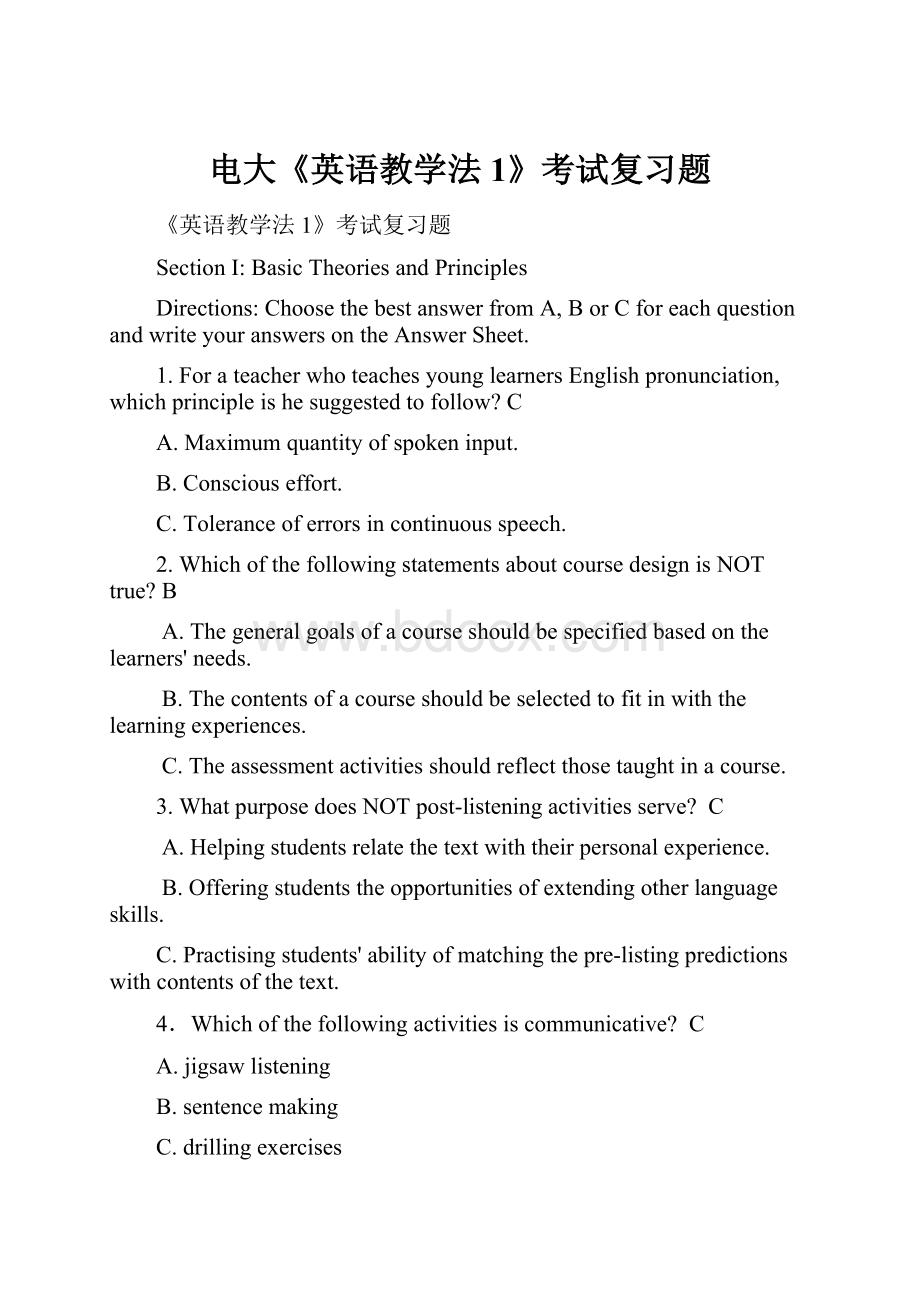电大《英语教学法1》考试复习题.docx
《电大《英语教学法1》考试复习题.docx》由会员分享,可在线阅读,更多相关《电大《英语教学法1》考试复习题.docx(15页珍藏版)》请在冰豆网上搜索。

电大《英语教学法1》考试复习题
《英语教学法1》考试复习题
SectionI:
BasicTheoriesandPrinciples
Directions:
ChoosethebestanswerfromA,BorCforeachquestionandwriteyouranswersontheAnswerSheet.
1.ForateacherwhoteachesyounglearnersEnglishpronunciation,whichprincipleishesuggestedtofollow?
C
A.Maximumquantityofspokeninput.
B.Consciouseffort.
C.Toleranceoferrorsincontinuousspeech.
2.WhichofthefollowingstatementsaboutcoursedesignisNOTtrue?
B
A.Thegeneralgoalsofacourseshouldbespecifiedbasedonthelearners'needs.
B.Thecontentsofacourseshouldbeselectedtofitinwiththelearningexperiences.
C.Theassessmentactivitiesshouldreflectthosetaughtinacourse.
3.WhatpurposedoesNOTpost-listeningactivitiesserve?
C
A.Helpingstudentsrelatethetextwiththeirpersonalexperience.
B.Offeringstudentstheopportunitiesofextendingotherlanguageskills.
C.Practisingstudents'abilityofmatchingthepre-listingpredictionswithcontentsofthetext.
4.Whichofthefollowingactivitiesiscommunicative?
C
A.jigsawlistening
B.sentencemaking
C.drillingexercises
5.Whichofthefollowingbelongstothecommunicativeapproach?
B
A.focusonaccuracy
B.focusonfluency
C.focusonstrategies
6.WhichofthefactorsappliestothelaterstageofthePPPModel?
C
A.Accuracy.
B.Classwork.
C.Delayedcorrection.
7.WhichofthefollowinggenerallydoesNOTdescribeaCLTsyllabus?
C
A.Thevocabularyandgrammarstructuresneededforcommunicativeobjectives(e.g.tellingdirections,requestinginformation,expressingagreement,etc.).
B.Theskillsrequiredintypicalsituations(e.g.listening,speakingorwritingskills).
C.Thegrammarruleappropriateforsocialoccasions(e.g.ataconference,ataparty,inagrocerystore,etc.)
8.Whichofthefollowingischaracteristicofacquisition?
C
A.form-focused
B.accuracy-oriented
C.meaning-focused
Unit1Self-introduction
Unit2Greetings
Unit3Askingtheway
Unit4Makingapologies
Unit5Inviting
Unit6Extendingthanks
9.Whatsyllabusdoesthefollowingpresent?
C
A.structuralsyllabus
B.topicsyllabus
C.functionalsyllabus
10.Whenateacherinstructsthestudentstomatchthetopicsentenceswithproperparagraphs,whichoneoftheskillsisheintendingtodevelopofhisstudents?
A
A.Skimming.
B.Scanning.
C.Inferring.
11.Whichofthefollowingismostsuitableforthecultivationoflinguisticcompetence?
A
A.sentence-making
B.cue-carddialogue
C.simulateddialogue
12.WhichofthefollowingactivitiesistypicaloftheGrammar-translationMethod?
C
A.Thestudentslistentoandactoncommandsinthetargetlanguage.
B.Thestudentswhispertheirwordsinthemothertonguetotheteacherwhothentranslatethemintothetargetlanguage.
C.Thestudentstranslatesomesentencesinthetextintotheirmothertongue.
13.Whichofthefollowingemphasizesmeaningfulnessprinciple?
C
A.TPR
B.Audio-LingualMethod
C.CommunicativeApproach
14.WhichofthefollowingistrueaccordingtoKrashen?
B
A.Babieslearntheirmothertongue.
B.Languageacquisitioncanbeachievedevenwithoutconsciouseffort.
C.Aforeignlanguagelearnershoulddevelophislanguageskillsintheorderoflistening,reading,speakingandwriting.
15.Whichofthefollowingistheteacherexpectedtodoinacommunicativeactivity?
B
A.Toofferthestudentsaslittlehelpaspossible.
B.Tocheckifthestudentshaveunderstoodtheinstructionsbeforetheactivitystarts.
C.Tocorrectthestudents'errorsimmediatelyaftertheyoccur.
16.Whatshouldtheteachertrytoavoidwhenselectinglisteningmaterials?
B
A.Tetextsscriptedandrecordedinthestudio.
B.Thetextswithimplicatedconceptsbeyondthecomprehensionofstudents.
C.ThetextsdeliveredthroughtheaccentsotherthanRPorStandardAmericanPronunciation.
17.WhichisthecorrectorderofthefollowingthreespeakingactivitiesalongtheControl-CommunicationContinuum?
B
A.Scrambleddialogue,prompteddialogue,gappeddialogue.
B.Gappeddialogue,scrambleddialogue,prompteddialogue.
C.Prompteddialogue,gappeddialogue,Scrambleddialogue.
18.Whenareadertriestoguessthemeaningofanewwordbasedonthecontextualclue,whichoneofthefollowingapproachesisheusing?
B
A.Bottom-upApproach.
B.Top-downApproach.
C.InteractiveApproach.
19.WhichofthefollowingactivitiesistypicaloftheGrammar-translationMethod?
C
A.Thestudentslistentoandactoncommandsinthetargetlanguage.
B.Thestudentswhispertheirwordsinthemothertonguetotheteacherwhothentranslatethemintothetargetlanguage.
C.Thestudentstranslatesomesentencesinthetextintotheirmothertongue.
20.WhichofthefollowingistrueaccordingtoKrashen?
B
A.Babieslearntheirmothertongue.
B.Languageacquisitioncanbeachievedevenwithoutconsciouseffort.
C.Aforeignlanguagelearnershoulddevelophislanguageskillsintheorderoflistening,reading,speakingandwriting.
21.WhichofthefollowingstatementsaboutcoursedesignisNOTtrue?
B
A.Thegeneralgoalsofacourseshouldbespecifiedbasedonthelearners"needs.
B.Thecontentsofacourseshouldbeselectedtofitinwiththelearningexperiences.
C.Theassessmentactivitiesshouldreflectthosetaughtinacourse.
22.WhichofthefollowinggenerallydoesNOTdescribeaCLTsyllabus?
C
A.Thevocabularyandgrammarstructuresneededforcommunicativeobjectives(e.g.tellingdirections,requestinginformation,expressingagreement,etc.).
B.Theskillsrequiredintypicalsituations(e.g.listening,speakingorwritingskills).
C.Thegrammarruleappropriateforsocialoccasions(e.g.ataconference,ataparty,inagrocerystore,etc.)
23.Whichofthefollowingistheteacherexpectedtodoinacommunicativeactivity?
B
A.Toofferthestudentsaslittlehelpaspossible.
B.Tocheckifthestudentshaveunderstoodtheinstructionsbeforetheactivitystarts.
c.Tocorrectthestudents"errorsimmediatelyaftertheyoccur.
24.Whichofthefollowingactivitiesiscommunicative.C
A.Thestudentsarerequiredtoanswerthequestionsaboutatext,
B.Thestudentsarerequiredtomakesentencesusingthegivenwordsorsentencestructures.
C.Thestudentsarerequiredtopresenttheirideasonatopic.
25.Whenareadertriestoguessthemeaningofanewwordbasedonthecontextualclue,whichoneofthefollowingapproachesisheusing?
B
A.Bottom-upApproach.
B.Top-downApproach.
C.InteractiveApproach.
26.Whenaresearcherreadsanacademicpapertoseeifitisrelevanttohisfieldofinterest,whichoneofthereadingskillsisheusing?
A
A.Skimming.
B.Scanning.
C.Inferring.
27.Whenateacherinstructsthestudentstomatchthetopicsentenceswithproperparagraphs,whichoneoftheskillsisheintendingtodevelopofhisstudents?
A
A.Skimming.
B.Scanning.
C.Inferring.
28.WhichofthefollowingactivitiesisdesignedtopractisetheskillofListeningforGist?
B
A.Afterlistening,thestudentsarerequiredtofillintheblankswiththewordsinthetext.
B.Afterlistening,thestudentsarerequiredtowriteasummaryofthetext.
C.Afterlistening,thestudentsarerequiredtomakeadialoguebasedonthetext.
29.Whatshouldtheteachertrytoavoidwhenselectinglisteningmaterials?
B
A.Tetextsscriptedandrecordedinthestudio.
B.Thetextswithimplicatedconceptsbeyondthecomprehensionofstudents.
C.ThetextsdeliveredthroughtheaccentsotherthanRPorStandardAmericanPronunciation.
30.WhatpurposedoesNOTpost-listeningactivitiesserve?
C
A.Helpingstudentsrelatethetextwiththeirpersonalexperience.
B.Offeringstudentstheopportunitiesofextendingotherlanguageskills.
C.Practisingstudents"abilityofmatchingthepre-listingpredictionswithcontentsofthetext.
31.WhichofthefactorsappliestothelaterstageofthePPPModel?
C
A.Accuracy.
B.Classwork.
C.Delayedcorrection.
32.WhichisthecorrectorderofthefollowingthreespeakingactivitiesalongtheControl-CommunicationContinuum?
B
A.Scrambleddialogue,prompteddialogue,gappeddialogue.
B.Gappeddialogue,scrambleddialogue,prompteddialogue.
C.Prompteddialogue,gappeddialogue,Scrambleddialogue.
33.ForateacherwhoteachesyounglearnersEnglishpronunciation,whichprincipleishesuggestedtofollow?
C
A.Maximumquantityofspokeninput.
B.Consciouseffort.
C.Toleranceoferrorsincontinuousspeech.
SectionII:
ProblemSolving
Directions:
Belowarefivesituationsintheclassroom.Eachhasaproblem.First,identifytheproblem.Second,provideyoursolutionaccordingtothecommunicativelanguageteachingprinciples.Youshouldelaborateontheproblem(s)andsolution(s)properly.
1.Inaspeakinglesson,ateacherasksstudentstoreadthemodeldialogueafterherthreetimes,andthenasksthestudentstoreadthedialogueinpairsforthreetimes.Next,theteacherexplainsthedialoguewordbywordtomakesurethestudentsunderstandall.
Problem:
Foraspeakinglesson,thereshouldbemoreopportunitiesforstudentstoconductoralactivities,especiallycommunicativeactivities.Butthislessonisfullofmechanicalpractice,anddeductiveexplanationofwordsandexpressions.Thefocusofthelessonisnotappropriate.
Solution:
Reducetheamountofmechanicalreading.Imitatingmodelpronunciationandintonationisimportant,butitshouldnottakeuptoomuchtime.Itisnecessarytoincludesomecommunicativeactivities.
2.Afterpresentingthemodeldialogueinaspeakinglesson,theteacherasksthestudentstoworkinpairstorole-playase